© 2014-

TV Noordzee
Towards the end of 1963 elaborate plans were being made for a new radio and television station based, not on a ship this time, but on a man-
Businessman I. P. Heerema and Rotterdam shipbuilder Cornelis (Cor) V erolme, together with business colleagues Joseph Brandel and M Minderop formed a company -
erolme, together with business colleagues Joseph Brandel and M Minderop formed a company -
The company's main objective was to provide an offshore commercial television service for a large area of Holland, hence the need for a stable structure from which to operate. Their oil platform style structure, which became known as the REM Island, was unique in offshore broadcasting history, being purpose designed and built in prefabricated sections, using the shipbuilding experience and facilities of a yard in Cork, Ireland owned by Cor Verolme.
The prefabricated sections were transported from Ireland on the MV Global Adventurer in May 1964, but the projec t nearly faced an early disaster when a dockside crane collapsed across the ship as it was being loaded in Cork harbour. The Global Adventurer had to sail from Ireland with the wreckage of the crane across her decks, calling in at Southampton to have it removed before continuing her voyage to a position in international waters six miles off Noordwijk on the Dutch coast where the artificial Island was to be erected.
t nearly faced an early disaster when a dockside crane collapsed across the ship as it was being loaded in Cork harbour. The Global Adventurer had to sail from Ireland with the wreckage of the crane across her decks, calling in at Southampton to have it removed before continuing her voyage to a position in international waters six miles off Noordwijk on the Dutch coast where the artificial Island was to be erected.
Similar in appearance to a North Sea oil rig, the legs of the REM Island were sunk through a 60' depth of water into the sea-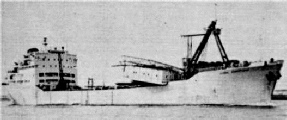 itter mast towering over 360' above sea level. The whole 'Island' measured about 40' x 80' with a helipad situated on top of the accommodation building so that supplies and programme tapes could be brought out to the station even during rough sea conditions.
itter mast towering over 360' above sea level. The whole 'Island' measured about 40' x 80' with a helipad situated on top of the accommodation building so that supplies and programme tapes could be brought out to the station even during rough sea conditions.
Accommodation 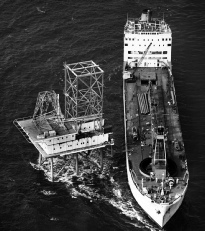 on the 'Island' consisted of a dormitory, kitchen, dining room, control room , generator room, crew cabins and a radio studio as well as a small television presentation suite comprising a studio used for broadcasting continuity announcements, on screen captions and station identifications a telecine equipment room and a control room. The 'Island' was staffed by a crew of seven maintenance engineers, mostly Belgians, and seven radio/television engineers (on contract from a British based company, Sicra Ltd.) who worked on a two week on, one week off rota.
on the 'Island' consisted of a dormitory, kitchen, dining room, control room , generator room, crew cabins and a radio studio as well as a small television presentation suite comprising a studio used for broadcasting continuity announcements, on screen captions and station identifications a telecine equipment room and a control room. The 'Island' was staffed by a crew of seven maintenance engineers, mostly Belgians, and seven radio/television engineers (on contract from a British based company, Sicra Ltd.) who worked on a two week on, one week off rota. 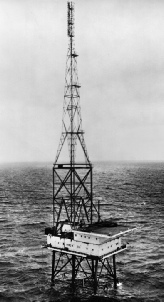
Construction of the 'Island' was completed during the night of 4/5th June 1964 and the broadcasting equipment was installed by communications giants RCA, after Pye the first company approached to equip the station, had refused the contract because they considered the offshore television and radio project to be unfeasible.
Test transmissions for the radio station on board REM Island started on 19th July 1964 on 1071kHz (280m) moving after a few days to 1485kHz (202m). On 23rd July the frequency was changed yet again to 1400kHz (214m) which proved to be more satisfactory and so on 29th July 1964, following an opening announcement in English, regular broadcasts under the call sign Radio Noordzee started in Dutch. The English announcement said:-
“Hello listeners in Holland. This is Radio Noordzee. This is the voice of the REM Island direct from Radio Noordzee. This is Radio Noordzee.”
Radio Noordzee then broadcast daily between 9.00am and 6.15pm with programmes of popular and chart music.

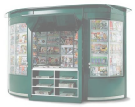

Click on picture to enlarge
A section of the REM Island en route to the Dutch coast, May 1964
Global Adventurer with sections of the REM Island on board, May 1964
REM Island under construction off the Dutch coast, May 1964
The completed structure
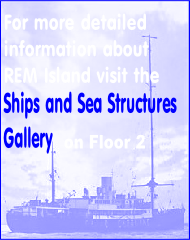
This video shows the first broadcast of TV Noordzee from the REM island,
including a documentary of the construction of the REM island in Ireland and in the North Sea near Noordwijk.




Floor 2
Back to




